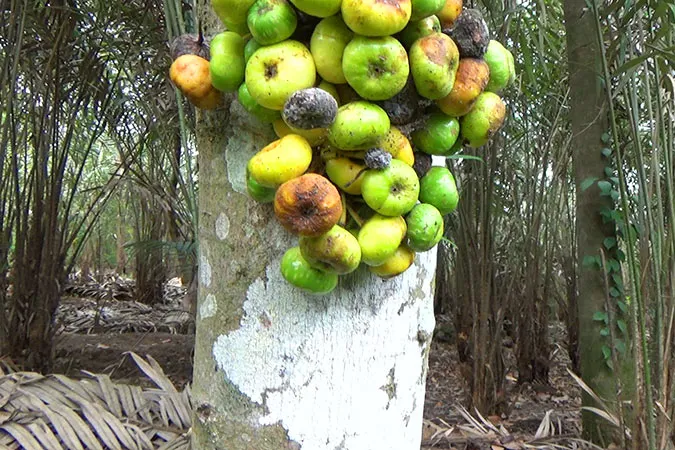Nyawai or common red stem fig (Ficus variegata) is a tree species in Moraceae, height up to 30-40 m and diameter 85-100 cm, buttresses up to 2 m and smooth surface, unisexual flowers, fruit buds appear directly on the stem and grow solitary in the tropics.
F. variegata has a single leaf, scattered, ovoid, heart-shaped base and pointed tip. Thin leaves with a size of 9-25x4-12 cm. Secondary veins for 4-8 pairs with base arranged like fingers and stem length of 2.5-18 cm.
Female flowers consist of an elongated and white stylus, ovaries, red colored calyx and pedicles. A flower bud becomes a ripe fruit for around 2-3 months. This tree starts to bear fruit at a young age.
Common red stem fig species require full sunlight, often found in burned natural forests and scattered along with other pioneer plants including jabon (Anthocephalus cadamba), mahang (Macaranga spp.), benuang bini (Octomeles sumatrana) and nuklea (Nauclea sp.) .
Nyawai grows at an altitude of 0-1000 m, rainfall 1700-3900 mm per year with an average of 148-266 mm per month and 9-14 days/month, temperature 21-32C and humidity 70-84%, pH 4.5 -5.2 on the soil of the red-yellow podsolic group with flat to moderate undulating topography.
The flowering and fruiting period is from May to June. Mature fruit has a variety of colors including dark green, reddish green to blackish red. Measuring around 34 mm and round, clustered and attached to the trunk and branches.
A tree can be found immature fruit and ripe fruit at once. Ripe fruit has a sweet taste and is liked by apes, birds, anteaters, porcupines and wild boars. The fruit contains very small and intermediate seeds with an amount of 3-5 million grains/kg.
Wood is brightly colored, whitish yellow and has a good complexion. The heating value is 4.225 cal/gram, the specific gravity is 0.20-0.43 and is classified in the strength class V and durability class V-III. It does not require special treatment to produce a good 1.5 mm veneer with a 910 peel angle.
Wood contains 74.42% holocellulose, 27.97% lignin, 19.75% pentosan, 2.84% ash and 0.439% silica. The wood will dry out within 11 days with a 50% moisture content to be reduced to 13% at a temperature of 20-33 C and humidity 62-85%.
Wood is used as plywood for face veneer, very good for temporary building construction, molding, interior, drawers, boxes for fruit and raw materials for pulp and paper. Leaves for deer feed. Fast growing trees are often used for reforestation and restoring degraded land.
Kingdom: Plantae
Phylum: Tracheophyta
Subphylum: Angiospermae
Class: Magnoliopsida
Order: Rosales
Family: Moraceae
Genus: Ficus
Species: Ficus variegata
Varieties: Ficus variegata var. chlorocarpa, Ficus variegata var. garciae
F. variegata has a single leaf, scattered, ovoid, heart-shaped base and pointed tip. Thin leaves with a size of 9-25x4-12 cm. Secondary veins for 4-8 pairs with base arranged like fingers and stem length of 2.5-18 cm.
Female flowers consist of an elongated and white stylus, ovaries, red colored calyx and pedicles. A flower bud becomes a ripe fruit for around 2-3 months. This tree starts to bear fruit at a young age.
Common red stem fig species require full sunlight, often found in burned natural forests and scattered along with other pioneer plants including jabon (Anthocephalus cadamba), mahang (Macaranga spp.), benuang bini (Octomeles sumatrana) and nuklea (Nauclea sp.) .
Nyawai grows at an altitude of 0-1000 m, rainfall 1700-3900 mm per year with an average of 148-266 mm per month and 9-14 days/month, temperature 21-32C and humidity 70-84%, pH 4.5 -5.2 on the soil of the red-yellow podsolic group with flat to moderate undulating topography.
The flowering and fruiting period is from May to June. Mature fruit has a variety of colors including dark green, reddish green to blackish red. Measuring around 34 mm and round, clustered and attached to the trunk and branches.
A tree can be found immature fruit and ripe fruit at once. Ripe fruit has a sweet taste and is liked by apes, birds, anteaters, porcupines and wild boars. The fruit contains very small and intermediate seeds with an amount of 3-5 million grains/kg.
Wood is brightly colored, whitish yellow and has a good complexion. The heating value is 4.225 cal/gram, the specific gravity is 0.20-0.43 and is classified in the strength class V and durability class V-III. It does not require special treatment to produce a good 1.5 mm veneer with a 910 peel angle.
Wood contains 74.42% holocellulose, 27.97% lignin, 19.75% pentosan, 2.84% ash and 0.439% silica. The wood will dry out within 11 days with a 50% moisture content to be reduced to 13% at a temperature of 20-33 C and humidity 62-85%.
Wood is used as plywood for face veneer, very good for temporary building construction, molding, interior, drawers, boxes for fruit and raw materials for pulp and paper. Leaves for deer feed. Fast growing trees are often used for reforestation and restoring degraded land.
Kingdom: Plantae
Phylum: Tracheophyta
Subphylum: Angiospermae
Class: Magnoliopsida
Order: Rosales
Family: Moraceae
Genus: Ficus
Species: Ficus variegata
Varieties: Ficus variegata var. chlorocarpa, Ficus variegata var. garciae
